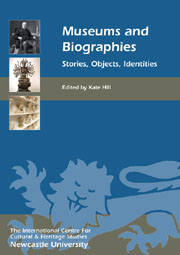Book contents
- Frontmatter
- Contents
- List of Illustrations
- Introduction: Museums and Biographies – Telling Stories about People, Things and Relationships
- INDIVIDUAL BIOGRAPHY AND MUSEUM HISTORY
- PROBLEMATISING INDIVIDUALS' BIOGRAPHIES
- INSTITUTIONAL BIOGRAPHIES
- 7 Significant Lives: Telling Stories of Museum Architecture
- 8 Schinkel's Museums: Collecting and Displaying Architecture in Berlin, 1844–1933
- 9 Personifying the Museum: Incorporation and Biography in American Museum History
- 10 Making an Exhibition of Ourselves
- 11 Institutional Autobiography and the Architecture of the Art Museum: Restoration and Remembering at the National Gallery in the 1980s
- OBJECT BIOGRAPHIES
- MUSEUMS AS BIOGRAPHY
- MUSEUMS AS AUTOBIOGRAPHY
- Endpiece: The Homunculus and the Pantograph, or Narcissus at the Met
- List of Contributors
- Index
10 - Making an Exhibition of Ourselves
from INSTITUTIONAL BIOGRAPHIES
Published online by Cambridge University Press: 05 February 2013
- Frontmatter
- Contents
- List of Illustrations
- Introduction: Museums and Biographies – Telling Stories about People, Things and Relationships
- INDIVIDUAL BIOGRAPHY AND MUSEUM HISTORY
- PROBLEMATISING INDIVIDUALS' BIOGRAPHIES
- INSTITUTIONAL BIOGRAPHIES
- 7 Significant Lives: Telling Stories of Museum Architecture
- 8 Schinkel's Museums: Collecting and Displaying Architecture in Berlin, 1844–1933
- 9 Personifying the Museum: Incorporation and Biography in American Museum History
- 10 Making an Exhibition of Ourselves
- 11 Institutional Autobiography and the Architecture of the Art Museum: Restoration and Remembering at the National Gallery in the 1980s
- OBJECT BIOGRAPHIES
- MUSEUMS AS BIOGRAPHY
- MUSEUMS AS AUTOBIOGRAPHY
- Endpiece: The Homunculus and the Pantograph, or Narcissus at the Met
- List of Contributors
- Index
Summary
In recent years, museums have staged a number of ‘exhibitions of exhibitions’. These experiments in institutional, curatorial and artistic revivalism have ranged from allusions to, and quotations from, past installations to full-scale re-enactments and reconstructions (Greenberg 2009). Some have reproduced assemblages that were first exhibited two centuries ago, while others have remounted exhibitions from the recent past. The motivations of the curators and artists responsible for these diverse projects have included the desire to mark famous anniversaries, to recuperate long-forgotten shows, to examine the effects of different modes of display and spectatorship, and to construct an archive of the immaterial through retrospective and performance practices. To give a flavour of the trend, examples of ‘re-dos’ have included historical reconstructions, notably ‘Art on the Line’ (2001), curated by David Solkin at the Courtauld Institute, a composite reconstruction of Royal Academy exhibitions staged in the Great Room at Somerset House between 1780 and 1836. The year 2009 saw two experiments in revisiting the avant-garde of the 1950s onwards: the transposition of Robert Morris’ famous 1971 exhibition ‘Bodyspacemotionthings’ at the (then) Tate Gallery to Tate Modern; and ‘Vides’, a retrospective of exhibitions of empty rooms organised by the Centre Pompidou. Past exhibitions have formed the subject of new ones, such as: ‘Art Treasures in Manchester: 150 Years On’ (2007) at the Manchester Art Gallery, which celebrated the 150th anniversary of the Manchester Art Treasures Exhibition; and ‘William Blake 1809’ at Tate Britain, a fragmentary evocation of Blake's unsuccessful one-man show mounted in rooms above his brother's hosiery shop in Soho, London.
- Type
- Chapter
- Information
- Museums and BiographiesStories, Objects, Identities, pp. 145 - 156Publisher: Boydell & BrewerPrint publication year: 2012



